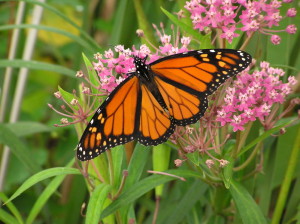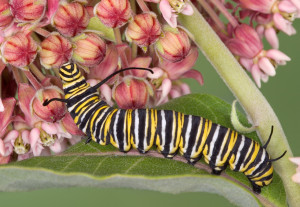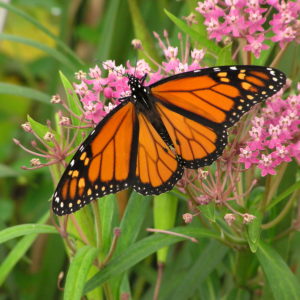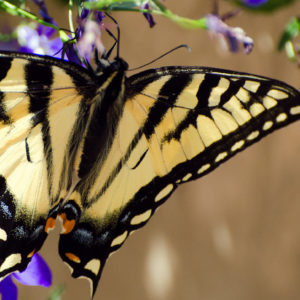Species Spotlight: Monarch
[separator headline=”h3″ title=”Here are some interesting facts about Monarch butterflies!”]

Monarch butterfly
Scientific Name: Danaus plexippus
SARA status: Special Concern; Ontario: Special Concern
Taxonomic Group: Arthropods
Size: wingspan of 8.6-10.5 cm
Adult monarch butterflies are orange and black with white spots on the borders of the wings. The caterpillars are black, white and yellow stripped and can be found on milkweed plants. The chrysalis is a distinctive green and gold. Monarchs can sometimes be confused with the similar-looking, but smaller Viceroy, but are easily distinguished by the lack of a black band on the hind wing that runs parallel to the wing edge.
During the summer months, you can find adult Monarchs feeding on the nectar of wildflowers, while the caterpillars can be found feeding on milkweed plants. You can encourage monarchs to come to your yard by planting a butterfly garden full of milkweeds and nectar-producing flowers, such as goldenrod, asters and black-eyed Susan. Want to plant your own monarch friendly garden? Check out Nature Canada’s tips here.

Monarch caterpillar
Photo Credit: Shutterstock
Monarchs have been in news lately as record low population numbers have been recorded in Mexico both this winter and during winter 0f 2013-14. It was hoped that during the 2014 summer breeding season, numbers of monarchs would improve. It appears, however, that this year the numbers of adult monarchs overwintering in Mexico are down by 80% compared to the historic average (source: WWF-Mexico). And if this spring is cold like last year’s, the spring migration could be delayed and fewer monarch sightings may be reported in their northernmost breeding grounds in Canada. There is fear that this year’s numbers could again be low, leading to an even longer road to recovery for the monarch population. But let’s hope that they will make a rebound this coming summer as monarchs, like most insects, can produce large numbers of offspring each year – and you can help them find the habitat they need!
On February 9th 2015 the US government announced $3.2 million in funding to help conserve habitat for monarch butterflies throughout their life cycle. This is a significant move by the US since the species is not yet listed under the US Endangered Species Act, despite the fact that the southern US and Texas are home to the first generation of monarchs that must survive to continue migrating north each year.
Where Can You See This Species?
There are two populations of Monarchs in North America, one to the west of the Rockies and the one to the East. The western population lives as far north as southern British Columbia and overwinters along the California coast. The population east of the Rocky Mountains is the population known for overwintering in the Oyamel Fir forests of Mexico. Monarchs can also be found in Central and South America, Australia, New Zealand, Hawaii and many other islands in both the Atlantic and Pacific oceans. Monarch are most commonly seen in eastern Canada from late spring to early fall.
Did You Know?
• Larvae ingest toxins from the milkweed making them poisonous to predators. The toxins stay in the body as the caterpillar pupates and the adult carries the toxins too.
• On their migration south, monarchs gather in large numbers along the Canadian shores of Lake Ontario and Lake Erie as they prepare to cross the water.
• The overwintering generation is the longest lived of the four or five monarch generations produced each year. These individuals can live about seven or eight months and are the ones that have migrated from their northern breeding grounds to the overwintering grounds in Mexico and they begin the journey north again in the spring. The other generations, living in the spring and summer months, survive for about two months.
You can report sightings of this and other rare species to the Canadian Wildlife Service at (819) 997-2800 or by registering for a free account at ebutterfly.ca. A photo and a location are very helpful!
This post is an update prepared by Alex MacDonald. Much of the content originally appeared as part of our Species Spotlight series under the NatureHood program, and was written by guest blogger Michelle Locke, then a contract research technician at the Canadian National Collection of Insects, Arachnids and Nematodes.



